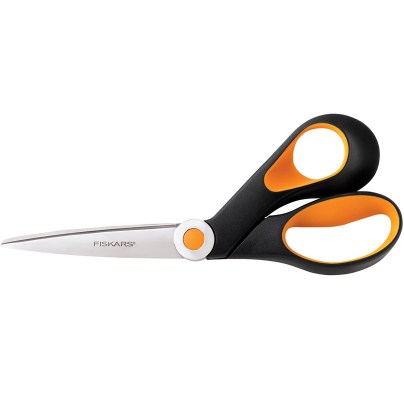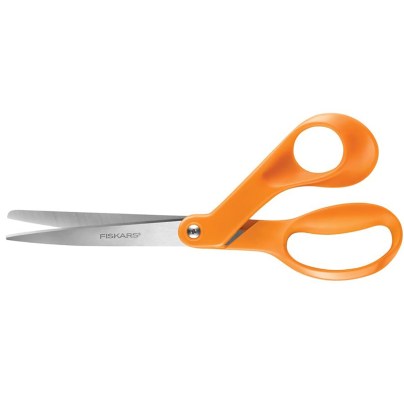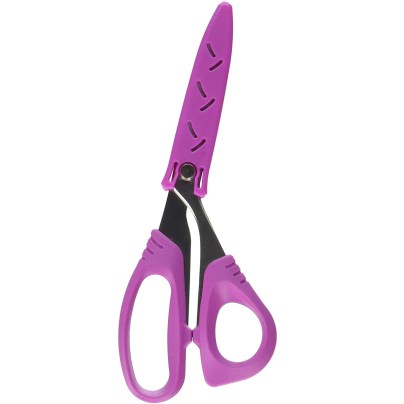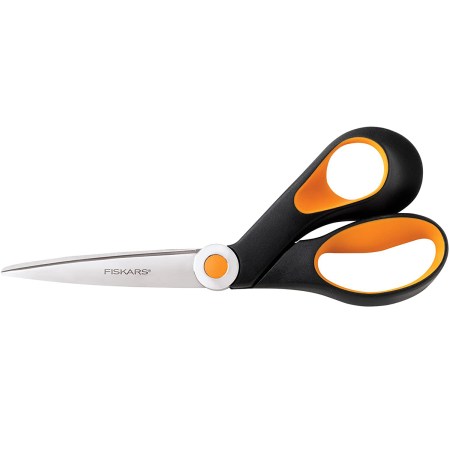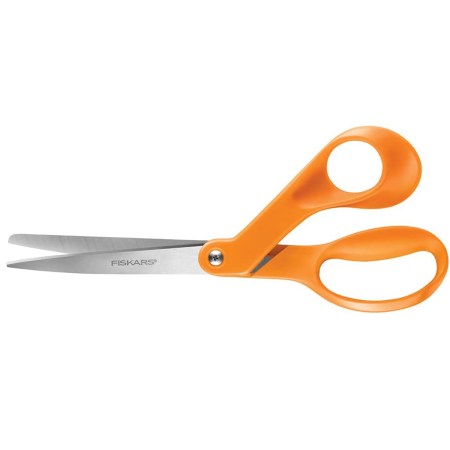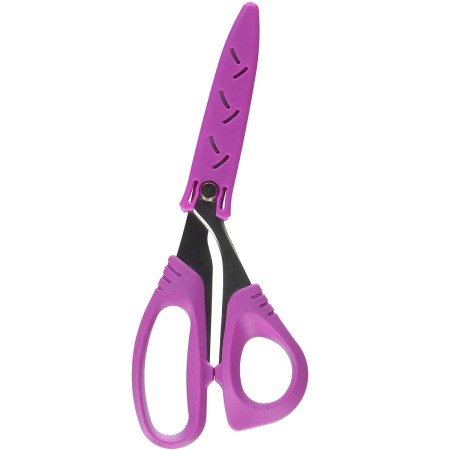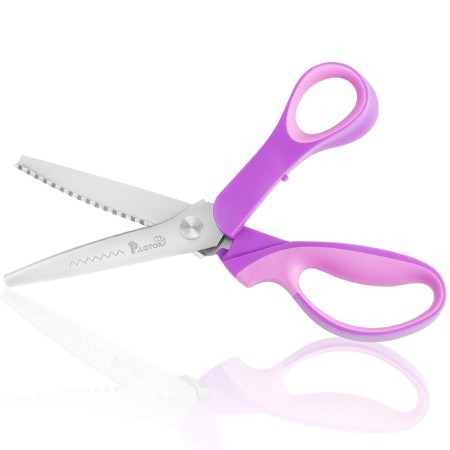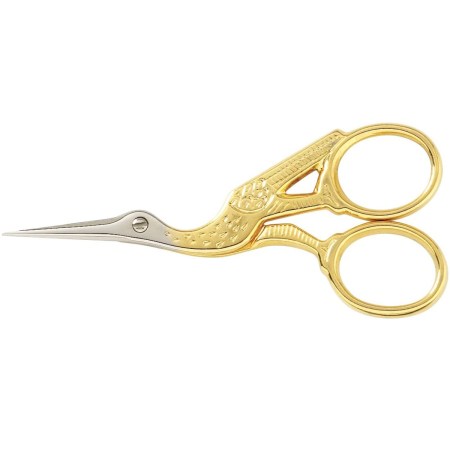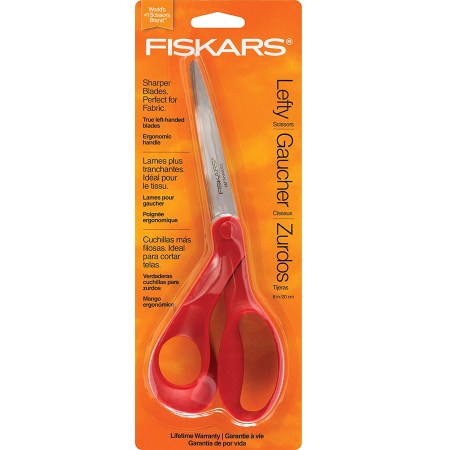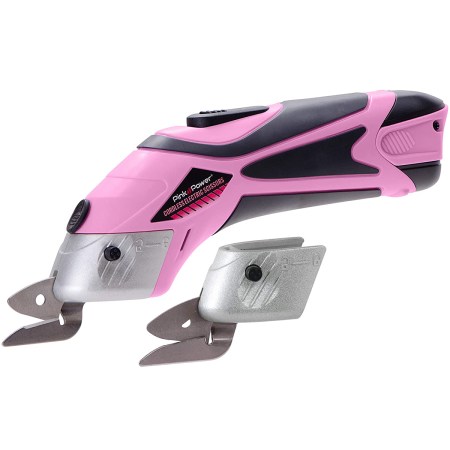We may earn revenue from the products available on this page and participate in affiliate programs. Learn More ›
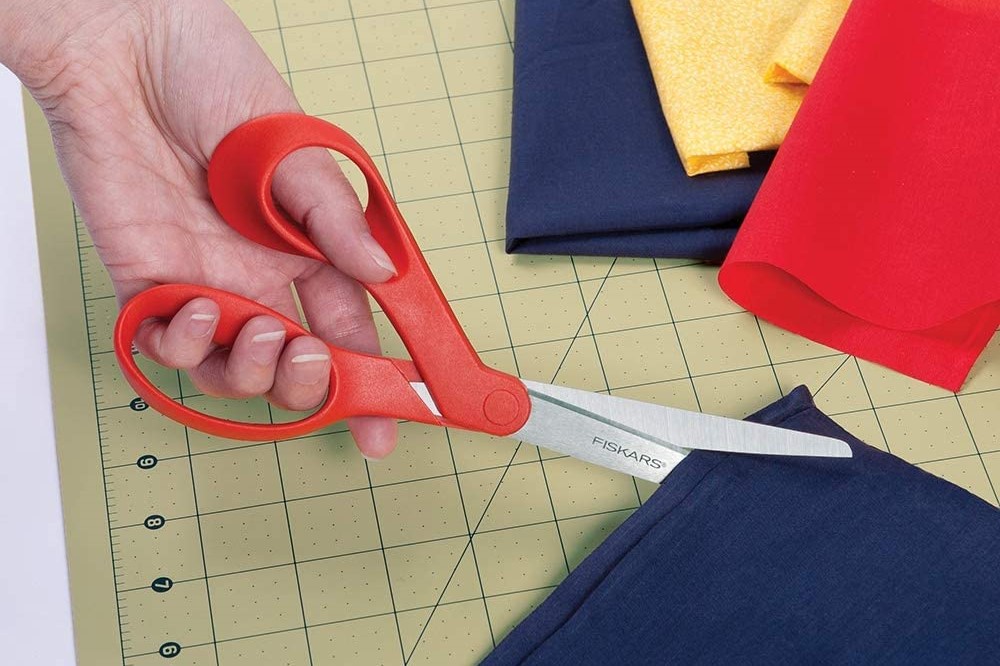
Anyone who sews knows that a quality pair of scissors will ensure the precision shaping of fabric pieces. Crafters and sewers usually have a dedicated pair of fabric scissors for sewing (and no-sew projects) and another pair for cutting paper, string, and other non-fabric objects.
Choosing the best fabric scissors can seem overwhelming due to the myriad choices available. The different types of sewing scissors include electric models, scissors designed for people with arthritis, and shears for dressmaking. The best fabric scissors should be sharp enough to cut through several types of fabric and fit comfortably in your hand.
Consider these recommendations for some of the best fabric scissors and important shopping considerations such as blade length, intended use, and handle style before you make your pick.
- BEST OVERALL: Fiskars 175800-1002 Razor-edge Softgrip Scissors
- BEST BANG FOR THE BUCK: Fiskars The Original Orange Handled Scissors
- BEST SERRATED SCISSORS: Havel’s 30212 Serrated Fabric Scissors
- BEST PINKING SHEARS: P.LOTOR Sewing Pinking Shears
- BEST EMBROIDERY SCISSORS: Gingher 01-005280 Stork Embroidery Scissors
- BEST LEFT-HANDED: Fiskars 1294508697WJ Left-hand Scissors
- BEST FOR ARTHRITIS: Pink Power Electric Fabric Scissors
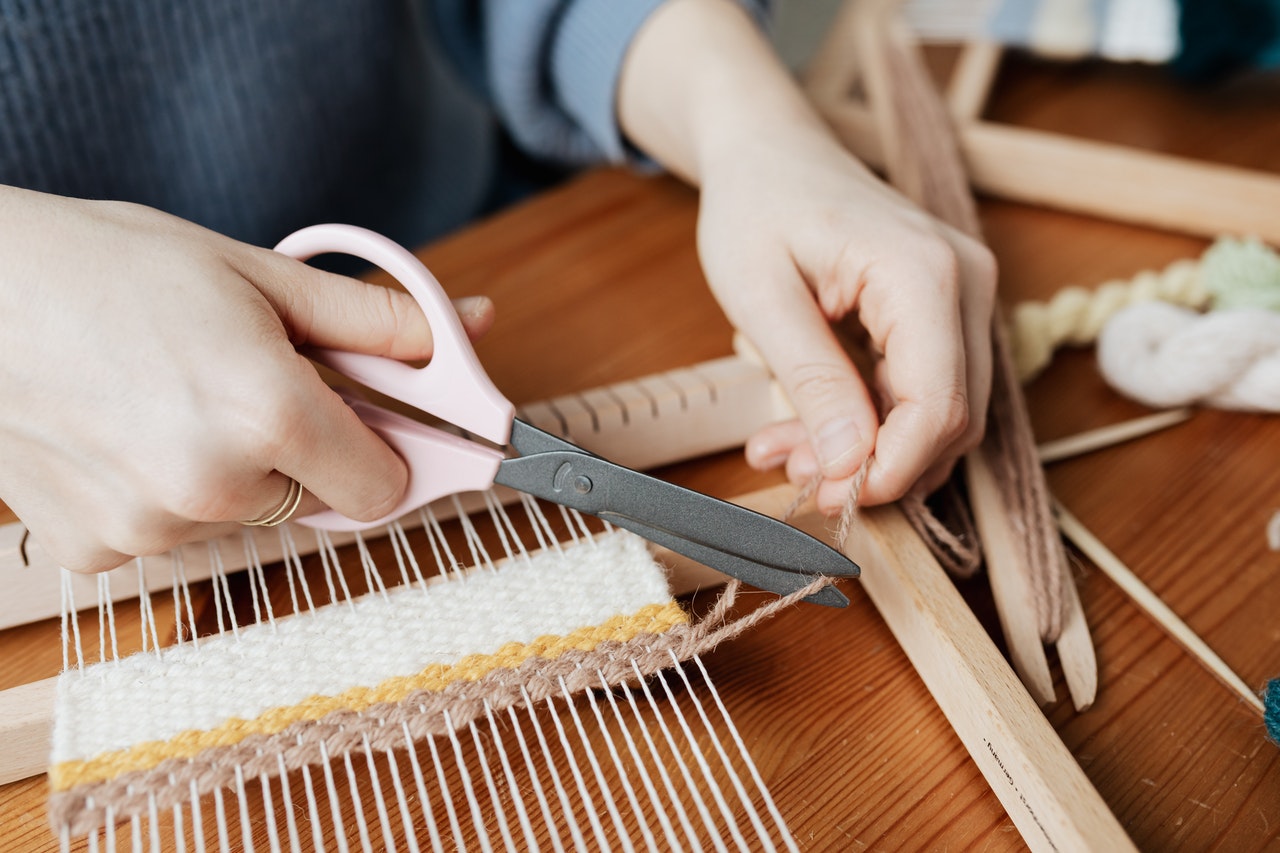
Common Types of Fabric Scissors
Not all scissors are the same. Sure, they are basically built to cut through things, but the many types of scissors are each designed for a specific job. When you reserve your scissors for their intended use, they stay sharper and last longer.
Shears Versus Scissors
If you cut fabric often, it’s better to invest in a pair of shears. Shears are more expensive than all-purpose scissors. What is the difference? Scissors have equally-sized, symmetrical holes on the handle for fingers and a blade length of fewer than 6 inches.
Shears, on the other hand, have two different size finger holes: a small finger hole at the top for your thumb and a larger hole at the bottom for your fingers. This allows you to place more fingers in the larger hole in order to apply additional pressure and have extra control when cutting. This helps you cut tougher materials with ease. The blades on a pair of shears are usually longer than 6 inches. The blades are also sharper and leave a clean cut without jagged edges.
All-Purpose Scissors
Most scissors are designed for a particular task except, that is, for all-purpose scissors. Also known as office scissors, these scissors have a straight blade and can be used for different tasks. All-purpose scissors are generally inexpensive.
If you plan to use all-purpose scissors to cut fabric, don’t use them on anything else. That will help keep the blades sharp and even. Using the scissors on paper and fabric will cause the blades to dull, and it will show in the jagged edges on your fabric.
Pinking Shears
Pinking shears feature serrated edges that create small zig-zag cuts in the fabric. Pinking the edge of fabric prevents it from unraveling or fraying. Pinking shears are commonly used as an alternative to using a serger machine.
Pinking shears range in length from 7 to 10-1/2 inches and feature a thicker, heavier blade than other shears. Pinking shears are good to use on most types of fabric, but they are ideal for fabrics that easily fray such as soft linens, cotton, and denim.
Embroidery Scissors
Embroidery scissors are small, delicate, and designed for making little snips. They feature very short, sharp pointy blades that can get between threads and pick out the one that you want to cut.
Embroidery scissors can cut one or two threads at a time with precision. They are not meant for cutting fabric or thick strings. These scissors are perfect for use in hand-sewing or to use next to your sewing machine for cutting threads as you sew.
Electric Scissors
Electric scissors are a hand tool that can cut layers of fabric, carpet, or other materials more easily. These tools are essentially electric shears that cut without having to manually move the blades. Electric scissors are available corded or battery powered.
Electric scissors are especially good for people suffering from arthritis or other joint or muscle conditions. They can cut fabric, craft materials, cardboard, paper, and plastic—just about anything manual scissors or shears can cut. These scissors are not designed for precise or detailed cutting. However, when you have a lot of material to cut, electric scissors are more productive than manual scissors.
Rotary Cutters
Rotary cutters are not scissors, but crafters, quilters, and sewers frequently use them to cut fabric. Rotary cutters consist of a handle with a replaceable circular blade that rolls as you push or pull it across fabric or other materials. Think of it as a pizza cutter for fabric.
Rotary cutters are far more efficient than scissors when it comes to cutting straight edges or multiple layers of fabric. They are easier on the hands and wrists, too, and allows you to cut a long, uninterrupted stretch simply by applying a little pressure. You do have to place a cutting mat under the fabric to protect the surface of the table when using this tool. And, for straight cuts, the tool works more precisely when it slides along the edge of a quilting ruler.
What to Consider When Choosing the Best Fabric Scissors
Consider these factors when you shop for the best fabric scissors for your sewing or crafting tool kit.
Fabric Type
A good pair of fabric scissors should easily cut through the type of fabric you work with the most. Fabric scissors should cut most types of fabric. But, for heavier, thicker materials, such as leather and denim, a pair of heavy-duty or electric scissors may be best. Crafting or quilting fabrics, like cotton and felt, are somewhat stiff. Most scissors can easily cut through them and leave a smooth edge.
Slippery fabrics such as chiffon, silk, or satin and other garment fabrics with drape (fabric that falls with graceful folds or attractive lines) are often more challenging to cut with smooth edge scissors. For these types of fabrics, it’s a good idea to use pinking shears or scissors with serrated blades. Serrated blades grab onto the slippery fabric, so it won’t slip as you cut it.
Intended Use
Quilting and garment-making require different cutting techniques. Quilters typically make straight cuts and work with stiffer fabrics. Garment makers work with fabrics that drape and need to make more curved cuts. Crafters work with various types of fabrics and materials. The best fabric scissors for you depends on your specific craft.
Rotary cutters or long-bladed fabric scissors work for quilters since they often cut multiple layers of fabric in straight lines. Garment sewers need fabric shears with ergonomic handles for intricate cuts and curves. All-purpose scissors are perfect for crafters that work with a variety of materials.
Blade Type & Length
There are three types of scissor edges: bevelled, convex, and serrated.
- Beveled edges, found on most garment shears, are very sharp and the most durable.
- Convex edges, found on embroidery and office scissors, offer the sharpest edge and the smoothest cut. But, they are extremely fragile and can lose their edge fast.
- Serrated blades feature a toothed or saw-like edge ground into the cutting surface. They work for slippery fabrics because they grip as they cut.
In general, the blades on a pair of scissors are less than 6 inches long; the blades on a pair of shears are longer. Shorter blades are good for trimming seams and facings, snipping off pieces of fabric, or for intricate cutting in tight corners. Longer blades work on heavy fabrics such as leather and denim or for straight cuts across a length of fabric.
The blades can be straight or angled. Dressmakers shears are angled (or bent) to keep the blades flat on the table while cutting. This helps you make long, uninterrupted cuts. Choose scissors with blades made from high-grade steel that can be sharpened. Keeping a sharp edge on your scissors will allow you to cut through fabric faster and leave a clean edge.
Handle
Scissor handles are available in various sizes, styles, and materials. Since you are providing the kinetic energy for the cutting action, choose an ergonomic handle molded for comfort. In general, scissors that have a larger hole at the bottom that fits up to three fingers tend to be more comfortable to use.
Handles may be plastic, rubber, or metal. But, what’s most important is that it fits comfortably in your hand. If it’s too large or too small, your hand will tire out as you cut.
If using shears with different-sized holes in the handle, be sure that that your thumb fits comfortably in the top hole and your middle, ring, and pinky fingers fit in the bottom larger hole. For scissors with two equal-sized holes in the handle, your thumb should comfortably fit through the top hole and either your index or ring finger should fit the bottom hole.
Left-handed vs Right-handed
The main difference between left- and right-handed scissors is the way the blades are connected. With right-handed scissors, the blade on the right (outside) goes up and the blade on the left (inside) goes down when you open it. It does not matter if you turn the scissors over or use it in your left hand—the blade on the right will always be at the top when you open the scissors.
With left-handed scissors, the blades are reversed. The top blade is always on the left so that the cutting line is visible. Although there are some scissors that claim to be ambidextrous, it is not possible due to the position of the blades. “Ambidextrous” scissors typically feature a non-bevelled handle with the blades connected for right-handers.
Our Top Picks
The best fabric scissors will ensure the precision cutting of fabric pieces and other crafting materials. When choosing the best fabric scissors for your tool box, look for handles that are comfortable and with the right blade length and edge for the fabric you work with the most.
Best Overall
Fiskars 175800-1002 Razor-edge Softgrip Scissors
See ItFiskars has been forging iron ore since 1649. The Finnish company manufactured its first pair of scissors in 1832. Since then, Fiskars’s iconic orange-handled tools are a common sight in homes everywhere.
Fiskars Razor-edge softgrip scissors feature an ergonomically sculpted softgrip handle that provides comfort and control. The softgrip handle reduces hand fatigue for comfortable extended use and cutting control.
The bent handle design keeps materials flat for precise cuts. The 8-inch blades made of hardened stainless steel are perfect for cutting through multiple layers of heavy material with minimum hand fatigue. Quality craftsmanship at an affordable price makes Fiskars Razor-edge Softgrip Scissors our top choice.
Best Bang For the Buck
Fiskars The Original Orange Handled Scissors
See ItFiskars introduced the world’s first pair of plastic-handled scissors in 1960. Incidentally, the handles were meant to be black. When the company decided to use some leftover orange plastic instead, the iconic orange-handled scissors were born. Even though the company does produce other color handles, the orange pair is by far Fiskars’s most treasured creation.
The Original Orange Handled Scissors are an all-purpose tool that can easily cut a wide variety of materials including denim, silk, and multiple layers of fabric. They feature 8-inch high-grade stainless steel blades and a bent handle for precision cutting. The handle is sculpted to fit snugly in your hand for maximum control and comfort. At this price point, it’s well worth buying several pairs for various dedicated crafting purposes.
Best Serrated Scissors
Havel's 30212 Serrated Fabric Scissors
See ItHavel Sewing has been making sewing and embroidery tools since 1981. The Cincinnati, Ohio company started off as a medical device business before adding sewing tools. The company is known in the sewing world for its scissors that are both functional and comfortable to use.
Slippery fabrics like chiffon, silk, and satin can be difficult to cut with straight-edge scissors. The smooth blades slide right off the fabric. In order to get a precise cut, use a serrated blade. Serrated scissors are like steak knives: they grab onto slippery or delicate fabrics to cut more effectively. They don’t leave a perfectly straight edge, but it’s not the zig-zag of pinking shears.
The 8-inch blades are made of high-quality stainless steel and have a fine, serrated edge. They’ll grab and cut through slippery fabric with ease and precision. These scissors also feature a comfortable handle that provides a secure grip for added control. They also come with a protective blade cover.
Best Pinking Shears
P.LOTOR Sewing Pinking Shears
See ItPinking shears cut a fray-resistant zig-zag edge. This is especially useful for fabrics like denim, cotton, and linens that tend to unravel when cut. Also, pinking shears allow you to put a professional-looking edge on your sewing projects. They make for an economic alternative to a serger machine.
Pinking shears typically feature thicker, heavier blades, which can make them cumbersome to use. However, the P.Lotor model is a lightweight 5 ounces with a soft ergonomic grip, so you can cut fabric for an extended period without extra pressure on your hand. The 9.3-inch stainless-steel blade easily cuts through most fabrics with ease and leaves a clean, pinked (zig-zag) edge. The ball-bearing joint helps ensure precision and smooth cutting action.
Best Embroidery Scissors
Gingher 01-005280 Stork Embroidery Scissors
See ItGingher has been recognized as the premier line of cutting implements for home sewing, crafts, needlework, and industry since 1947. They produce quality cutting tools that are beautiful as well as functional. Their Stork Embroidery Scissors are a true testament to Gingher’s craftsmanship.
Even if you do not embroider, a good pair of thread-snippers are a must for crafters. These types of scissors are built for precision cuts. They have short, sharp blades that cut thread cleanly with a single snip instead of a shred.
The Gingher Stork scissors are 3-1/2 inches long with a slender frame, making them ideal for cutting threads, not heavier yarns or fabrics. They feature nickel-plated blades and gold-plated handles for durability and beauty. They come with a fitted leather sheath for storage. These scissors make a great gift for crafters or sewing enthusiasts who always have room for an extra pair of snippers.
Best Left-Handed
Fiskars 1294508697WJ Left-hand Scissors
See ItScissors should mimic the natural squeezing action of your hand as you cut — whether you cut with your right or your left. True left-handed scissors have properly mounted blades (see Left-handed vs Right-handed), so that lefties can keep the cutting line in sight. For precision cutting, skip those “ambidextrous” scissors. They are not designed for left-handed users. Instead, pick up Fiskars’s left-handed version of its popular Orange-Handled Scissors.
Featuring the same ergonomic bent handle design and 8-inch, stainless-steel blades, these scissors will cut a wide variety of materials including denim, silk, and multiple layers of fabric. Best of all, they cost the same as the original Orange Handled Scissors. So, there’s no paying extra for “specialty” scissors.
Best For Arthritis
Pink Power Electric Fabric Scissors
See ItElectric scissors are great for those who have hand mobility issues or for large-volume repetitive cutting. The Pink Power electric scissors feature a soft grip handle that makes this device comfortable to use for prolonged periods of time without pain. At just under a pound and less than 9 inches long, they’re easy to store and carry.
The Pink Power comes with two unique blades, one for fabric and paper and the other for cardboard and metal, which are easy to swap out in seconds. The electric scissors come with a lithium-ion rechargeable battery that will give you 2 hours of cutting time on a single charge. This gadget is truly ambidextrous: left-handed crafters won’t have too many problems using these scissors.
Tips for Using Fabric Scissors
In order to easily and smoothly cut through fabric, you need scissors designed for your project and that have sharp edges with a comfortable, firm grip. To get the best performance from your fabric scissors, follow these rules of thumb:
- Have one pair of dedicated scissors for cutting fabric and another for paper. Do not use fabric scissors on paper. This will dull the blades.
- Choose scissors based on the type of fabrics you cut the most. It’s advisable to have more than one pair of scissors in order to accommodate various cutting needs.
- Keep your blades clean for maximum performance. Wipe away fabric fuzz and debris after cutting and store them in a sheath (if possible) when not in use.
FAQs About Your New Fabric Scissors
Picking the best pair of fabric scissors can save you from frustration when working on a sewing project. With so many options available, you may still have a few questions about fabric scissors.
Q. What are fabric scissors used for?
Fabric scissors are dedicated to cutting tools only used for fabric. However, they can also cut paper and other materials.
Q. How are fabric scissors different from regular scissors?
Regular scissors are used for paper and anything else that is not fabric. They are typically less expensive than fabric shears. Quality fabric shears will last longer and make a cleaner cut on fabric.
Q. How often will I need to sharpen fabric scissors?
It depends on how often and how much you use them. For moderate use, plan on sharpening them yearly.
Q. How do you choose the right scissors for embroidery?
There are several styles of embroidery scissors, but straight tip scissors are the most common. They have slender blades and fine points for cutting close to the fabric.
